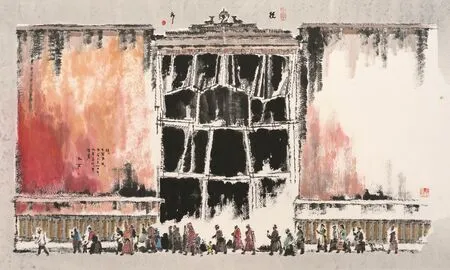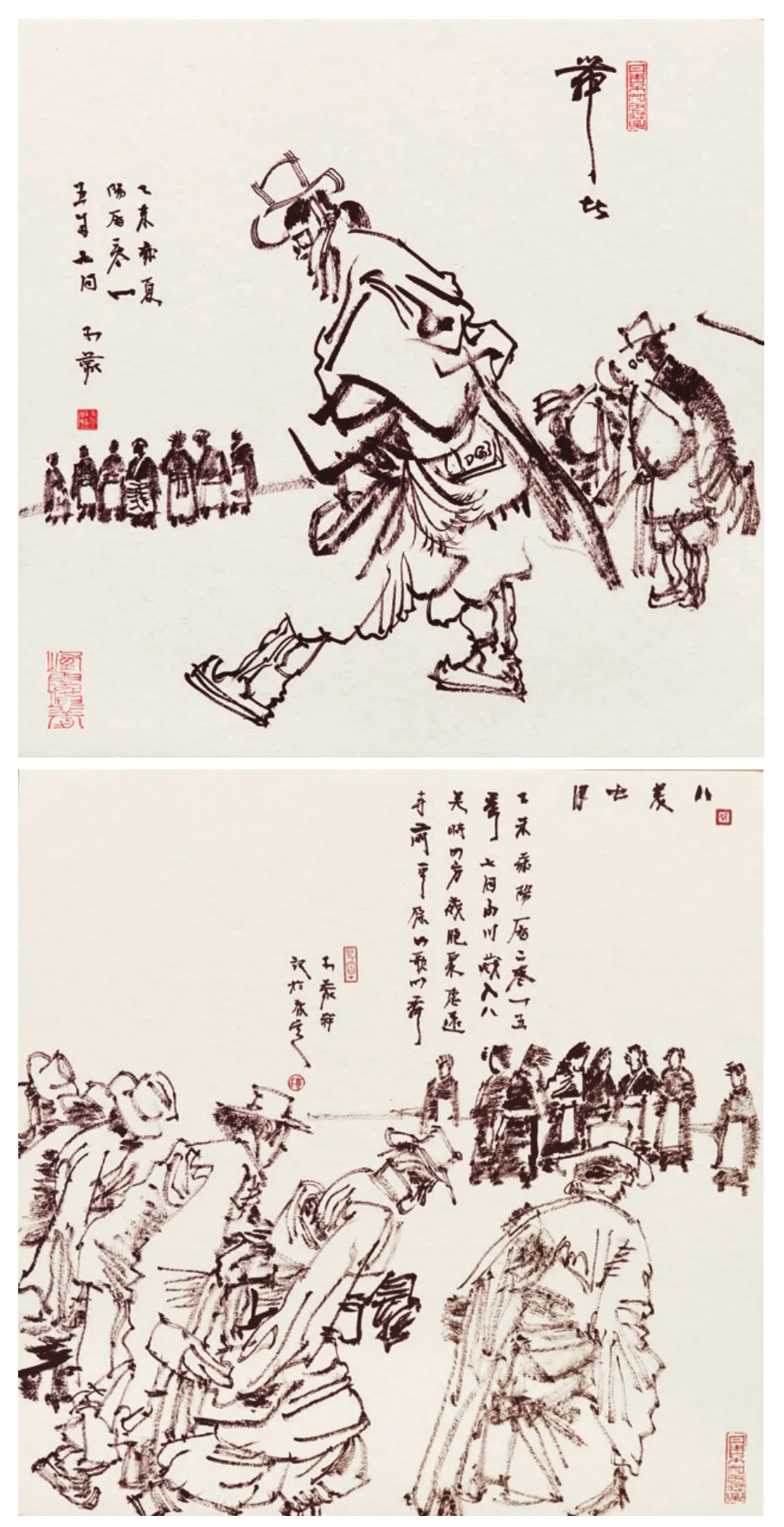陈航:一路向西27年
◇文| 本刊记者见习记者 图|
Article | Chen Kelong Li Tingting Pictures | Interviewee
2017年12月的一个午后,法国南部小城阿尔比阳光甚好。
图卢兹•劳特累克博物馆内,一位来自重庆的画家,背着手,弯着腰站在一幅油画前,盯着一幅油画看得入神。
画家名叫陈航。那幅油画,出自西方现代绘画立体主义先驱保罗•塞尚之手。亲眼看到“偶像”的真迹,陈航兴奋得忘记了时间,看了整整一天。
It was a sunny afternoon in Albi, southern France, in December 2017. In Musée Toulouse-Lautrec there stood a man. Hands behind his back and bending, he fixed his eyes at an oil painting, quite entranced.
The man is a painter named Chen Hang from Chongqing, and the oil painting enchanted him is a work of Paul Cézanne, the modern western cubism painting pioneer. Chen Hang was so excited to see the authentic masterpiece of his icon that he planted himself there for a whole day.
把“家”安在敦煌Settling in Dunhuang
到法国之前,陈航刚在重庆办完个人创作展。第一次见到陈航,正是展览开幕那天,2017年11月18日。
瘦瘦高高的陈航从人群中走来,笑容满面。一副无框眼镜,一身黑色衣裤,迈着大步走进了重庆两江美术馆,与来宾一一寒暄。
一楼的展厅面积不大,不过每面墙上都挂着陈航的作品。它们有一个共同的主题:“西部”。
正厅的墙上,一幅长2米、高1.2米的国画《冈仁波齐》,尤为摄人眼球。画面中,白红黑三种色彩,层次分明,明快笔直线条下的冈仁波齐,巍峨雄壮。
国画上方,悬挂了一条红色横幅——禹迹西望,逐梦丝路:陈航西行写生创作展。
2016整整一年,以及2017年近半年的时间,陈航流连忘返于遥远的大西北。不但自己西行,
他还带着妻子和年幼的儿子,把家安在了敦煌, 过起了日子。早上,妻子出门买菜,陈航就把儿子送到飞天幼儿园,然后自己带上画笔,游走在敦煌。

行书对联
Before heading for France, Chen Hang just finished the exhibition of his own works in Chongqing.
The first time we saw him is the very day of the exhibition’s opening, November 18, 2017.
Chen Hang, slim and tall, wearing rimless glasses and in all black, strode into the Galaxy Museum of Contemporary Art and greeted the guests one by one with all smiles.
Over 40 Chinese paintings were hanging on each wall of limited exhibition space at the first floor. All of these paintings have a same theme, “Western China”.
On the wall of the main hall hangs a quite eyecatching one—Mt. Gang Rinpoche, with a length of 2 meters and a height of 1.2 meters, which depicts the majestic and magnificent mountain with white, red,and black, distinct layers and straight lines.
Over the painting hangs a red banner saying “Pursuit along the Silk Road: Chen Hang’s Sketch in the Journey to Western China”.
From 2016 to 2017, Chen Hang spent a year and a half lingering in Northwest China.He even took his wife and son to settle in Dunhuang. In the morning, his wife went out for groceries, and he went out for sketching around the city alone after sending his son to kindergarten.
浪漫的西行写生Romantic Sketching Journey to the West
陈航从法国回来后,我们在一家咖啡馆再次相见。聊得最多的,是他那些西行途中的故事。
第一次入藏,是陈航跟随画家段七丁先生去写生。那是1991年的夏天,陈航还是个28岁的小伙子。年轻跳跃的心,一到了西藏,便沉静了下来。

《经行》
见我们对西藏很陌生,陈航主动拿过我的本子,翻开一页白纸,简单几笔就勾画出了一张地图。
地图上有四根弯曲的线条,分别是滇藏线、川藏线、青藏线和新藏线。“四条进藏线,我都跑过。”陈航扶了扶眼镜,略带自豪地说。
“这里,冈仁波齐雪山。”陈航在地图上圈出来,回忆起了与冈仁波齐的相遇,“2016年,我到冈仁波齐,前后经过四次,前三次都没见到雪山,云雾太大了。第四次,返程路上,我才有幸见到它的真容。”
谈起西部的风土人情,陈航更是眉飞色舞。“阳关外,看着苍茫的塞外,我真是不自觉就念出了‘前不见古人,后不见来者。念天地之悠悠,独怆然而涕下’这首诗。”
浪漫与挚爱,溢于言表。
玉门关的萧索、古格王朝遗迹的悠远、冈仁波齐的神圣、托林寺的古拙……写生路上的每一处,对他来说都是生命的奇遇。
After his trip back from France, we met up again in a café. He talked most about the stories of his journey to western China.
He first went to Tibet in the summer, 1991,following painter Duan Qiding sketching there.As a 28-year- old boy, young and restless, he surprisingly felt calmness down upon the entrance into Tibet.
Noticing that Tibet is strange to us, Chen Hang took my notebook and drew a fairly simple map.
On the map were four curving lines, showing four highways to Tibet from Yunnan, Sichuan,Qinghai and Xinjiang. “I tried all of them.” He raised his glasses, and said somewhat proudly.
Chen Hang outlined Gang Rinpoche on the map.He recalled that he missed any sight of it for the first three time and made it till the fourth time.
He went into raptures at the mention of landscape in western China.
Indeed, his love for the west is beyond words.
For Chen Hang, every single place on the sketching journey is a treasure in his life.
以直为曲的美Straight Lines in Painting Creates Beauty

《青藏日记》
与塞尚的“相遇”,则是陈航的另一大收获。塞尚对于线条的运用,直接影响了他在传统国画上的创作。
传统水墨丹青中的线条,多以曲为直,为了在国画创作上不落窠臼,陈航在线条上做出了改变。他近年的作品,线条多以直为曲,《冈仁波齐》正是代表。
“美,将万物归纳为直线 。”陈航喜欢塞尚作品呈现出的立体感,也喜欢同样爱用直线的清代画家虚谷,“在虚谷的画作中,直线虽多,而境界空灵。”
陈航浸润传统中国画多年,如何在传统国画上推陈出新,一直是他思考的问题。“一下笔就是古人,我不愿一直重复古人。”陈航坦言,要想用古人的语汇超越古人,实非易事。
西部的游历写生,让他开始有意放下传统,远离传统中国画惯用的表现手法。不过,打破传统并非丢掉传统,陈航明白,“传统是我的根基,已经内化于心。我的创新,在于打破国画传统的题材界限。”
“在他近年创作的作品里,那种‘宏大叙事’般的大开大合、浑然幽深、气势撼人的图式渐渐地少了,而更多地以一种近乎‘临景’的图式表现大西北的所见所闻。”四川大学艺术学院院长、教授黄宗贤,对陈航的“创新”如此评价。
一如我们在陈航个展上,看到的那些作品,无物不可入画。
Paul Cézanne’s use of lines exerted direct influence on Chen Hang's work in traditional Chinese painting.
Chen Hang made some changes to traditional Chinese painting lines that are mostly curved. Most of his recent works are more of straight lines, and Mt. Gang Rinpoche is one of the representatives.
“All beauty lies in the straight lines.” Chen Hang loves the cubic effect in Cézanne’s works and Chinese Qing dynasty artist Xu Gu who preferred straight lines in painting.
Engaged in traditional Chinese painting for years, Chen Hang has been always thinking about how to make innovations in the area.
The sketching journey to the west of China enabled him to put aside the conventional skills in traditional Chinese painting. But he knows clearly that it does not mean casting away the tradition.“What I want now is to break the limit of traditional painting subjects.”
“There are less heavy, grandiose depictions in his latest works, and more vivid portraits of the earthly scenes in western China instead,” Remarked Huang Zongxian, professor and dean of Sichuan University’s College of Arts.
Just as the pictures we saw on Chen Hang’s solo exhibition, nothing cannot be put into a painting.
以书入画的功力Combination of Calligraphy and Painting
聊到午后,陈航从手提包里拿出了一本刚出版的画册——《当代中国书画大家:陈航卷》。
一幅《甘青日记》引起了我们极大的兴趣,画面中的塔寺与题跋,笔墨枯少,又奇妙地相得益彰。

《八美》之一、之二
陈航解释,“这是渴笔法,塔寺一笔而就,就像写字一样,不作停顿。”
画册中还有许多作品采用了渴笔法。陈航认为,它非常适合表现大西北的苍茫。这也要求画家得有过硬的书法功底。
事实上,陈航青年时就随大哥陈争一起学习书画。攻读博士时,陈航的专业正是书法。
陈航的哥哥陈争,现在是贵州省美术家协会副主席、贵州画院院长、贵州省美术馆馆长。在他眼中,弟弟陈航“在同辈的国画家中,无论是学理探究的广度,文史修养的全面,书法历练的精深,包括传道解惑的能力,陈航所达到的高度,能匹敌者委实寥若晨星”。
陈争对弟弟在书法上的造诣,同样知之甚深,陈争曾说,“我们在陈航的作品中看不到懈怠疲软的笔墨,而点画间总是充盈着精气神的旺健和情理之中意料之外的笔外之笔,墨外之墨,味外之味。”
In the afternoon, Chen Hang took out a newly published painting album: Contemporary Chinese Painter—Chen Hang.
In the album the painting Ganqing Diary interested us a lot, in which the pogodas and temples as well as the calligraphy inscription seemed to be finished with somewhat dry ink but very harmonious altogether.
“This technique is called drybrush. The temples and pogodas are painted with none stop, just like in calligraphy,” Chen Hang explained.
The dry brush technique is used in many other works in the album. It is perfect for depicting the vastness of Northwest China, according to Chen Hang, but it asks for a painter’s good handling in calligraphy.
Actually, Chen Hang followed his brother Chen Zhen to learn calligraphy and painting since he was young, and his doctor’s degree was majored in calligraphy, too.
His brother Chen Zhen now is the vice president of Guizhou Artists Association, dean of Guizhou Painting Institute, as well as the curator of Guizhou Art Gallery. In light of him, “No matter it is in academic study or calligraphy, accomplishment in culture and history or in education, Chen Hang exceeds a lot most of the other counterparts.”
Chen Zhen knows well his younger brother’s attainments in calligraphy as well. He remarked, “In Chen Hang’s works, there is never sluggishness but always vigor and energy. His strokes may be out of your expectation but keep within understanding,and will leave you a lingering taste.”

